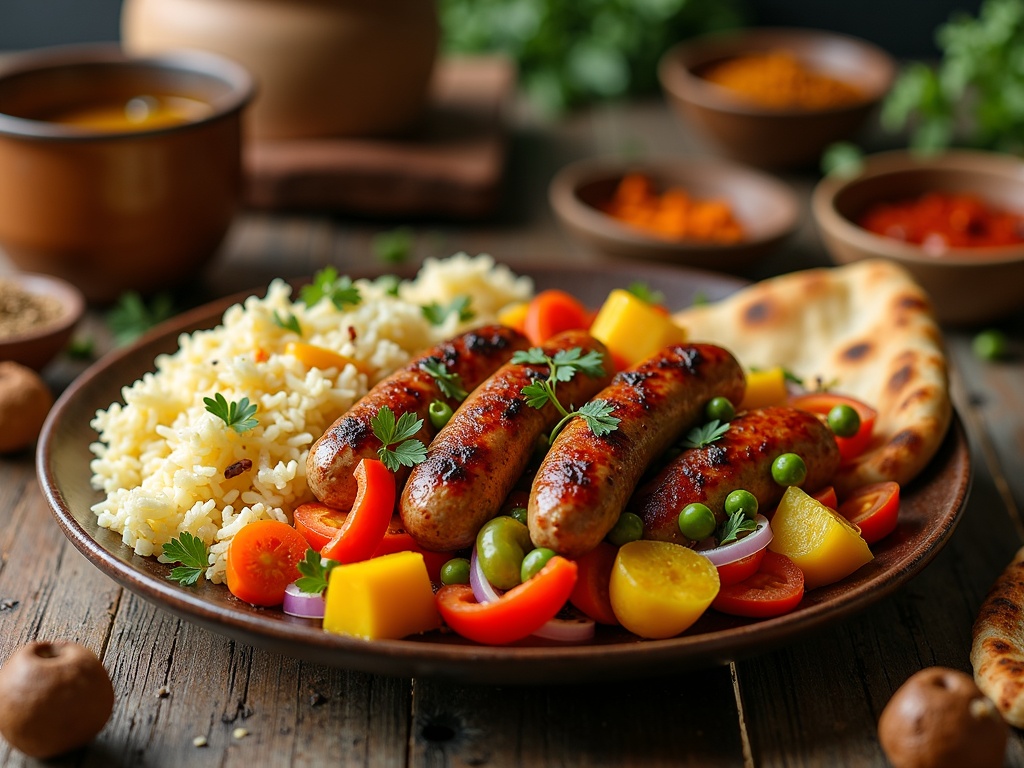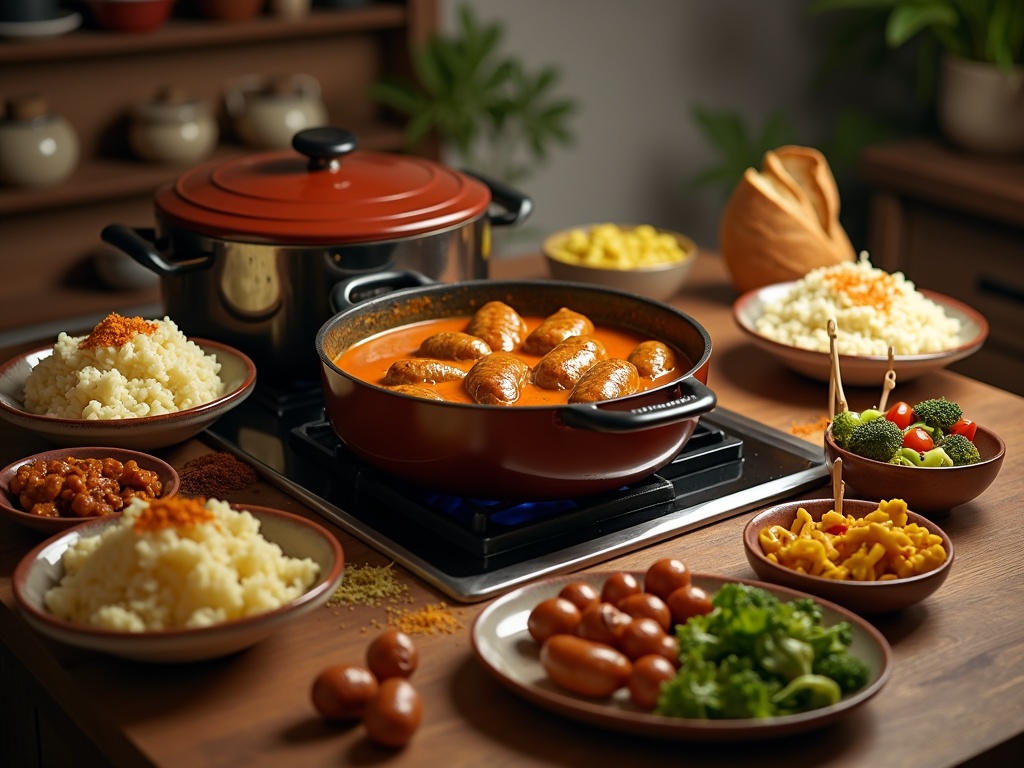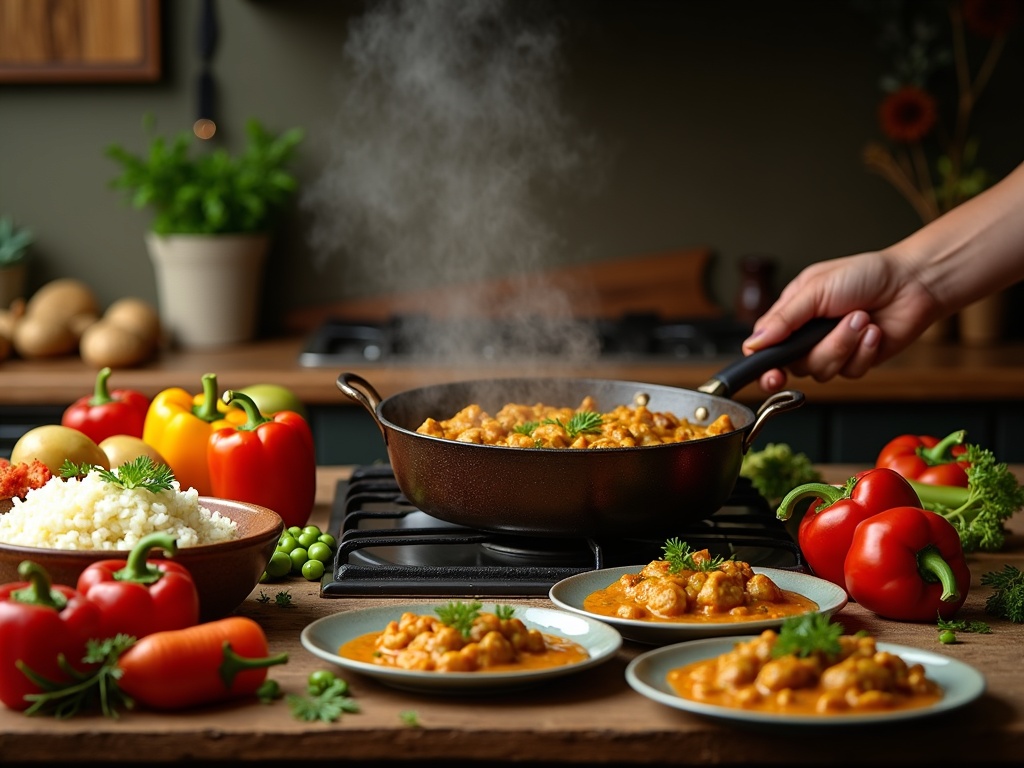Curried sausages emerged in 1940s Australia as a comfort food that perfectly blends British colonial influence with Asian flavors. This iconic dish—sausages in a curry-flavored sauce with vegetables—has found its place in about 65% of Australian households while adapting to modern preferences.
Find In This Article
Key Takeaways
- Curried sausages originated in 1940s Australia and gained popularity in the 1950s-60s as an affordable, filling meal option with exotic flavors.
- The dish holds significant cultural importance in Australian identity, appearing at community gatherings, sporting events, and family dinner tables across generations.
- The perfect curry sauce typically uses about 15g of curry powder per serving, featuring a balanced blend of turmeric, cumin, coriander, and chili powder.
- The recipe is highly adaptable, allowing for various cooking methods (stovetop, slow cooker), vegetable combinations, and serving options like rice, mashed potatoes, or bread.
- While moderately calorie-dense (350-500 calories per serving), the dish can be made healthier by choosing leaner sausages, increasing vegetables, and controlling oil usage.
Origins traced to 1940s Australia
Curried sausages have become deeply embedded in Australian culinary tradition, finding their way into approximately 65% of Australian households. This iconic dish emerged during the post-war era of the 1940s, when resourcefulness in the kitchen was essential and exotic flavors were beginning to influence Australian cooking.
The dish itself is beautifully simple—sausages simmered in a curry-flavored sauce that often includes vegetables like peas, carrots, and potatoes. It represents the perfect marriage between British colonial influence and the growing awareness of Asian flavors that would later transform Australian cuisine.
The popularity of curried sausages skyrocketed during the 1950s and 1960s, as families sought cost-effective, filling meals that offered something different from typical meat-and-three-veg dinners. The curry powder used in these early recipes wasn’t particularly authentic to Indian cuisine but rather represented the Anglo-Indian interpretation that had made its way to Australia via British connections.
Cultural Significance in Australian Life
I’ve noticed how curried sausages hold a special place in Australian cultural identity. This dish transcends mere sustenance to represent something uniquely Australian—a blend of practical cooking and multicultural influence that characterizes the national approach to food.
For many Australians, curried sausages trigger powerful childhood memories. The aromatic combination of curry powder, sizzling sausages, and sweet vegetables creates a sensory experience that connects generations. It’s a dish that grandparents made for parents, who then made it for their children, creating a thread of culinary continuity in Australian family life.
Beyond the home kitchen, curried sausages have established themselves in community gatherings across the country. You’ll find them served at:
- School fundraisers and community fetes
- Sporting club canteens throughout regional Australia
- Traditional “Sausage Sizzles” with a curry-flavored twist
- Country town social events and farmers’ markets
The appeal of curried sausages at these communal events stems from their accessibility. The dish is unpretentious yet satisfying, affordable to produce in large quantities, and carries that comforting familiarity that brings people together.
What makes this dish particularly fascinating is how it’s evolved while maintaining its core identity. Contemporary versions might include premium beef or chicken sausages instead of traditional beef or lamb. Some cooks add apples for sweetness, others incorporate coconut milk for richness, and many have personalized family recipes passed down through generations.
While curried sausages might not feature prominently in high-end restaurants, they remain firmly entrenched in home cooking repertoires. The dish offers an easy weeknight solution that satisfies the whole family, which partly explains its enduring popularity. For busy families looking for quick, satisfying meals, curried sausages deliver comfort and flavor without fuss—much like this sausage casserole that offers similar convenience with a different flavor profile.
As Australia’s culinary landscape has become increasingly sophisticated, curried sausages have maintained their place by adapting just enough while retaining their essential character. This resilience speaks to the dish’s status not just as food but as a cultural touchstone that continues to resonate with Australians of all backgrounds.
The story of curried sausages reflects broader patterns in Australian history—adaptation, practicality, and the gradual embrace of global flavors. From humble post-war beginnings to contemporary dinner tables, this unpretentious dish continues to tell a uniquely Australian story.
The Perfect Curry Sauce and Sausage Combination
Creating a flavorful curried sausage dish begins with the right balance of spices and quality sausages. I’ve found that the magic happens when these two elements complement each other perfectly.
Crafting the Ideal Curry Sauce
The secret to an authentic curry sauce lies in the spice blend. A standard recipe typically uses about 15g of curry powder per serving to achieve that perfect flavor intensity. This isn’t just any powder though – it’s a carefully balanced mixture of turmeric, cumin, coriander, and chili powder that creates that distinctive curry taste we all love.
Each spice plays a crucial role:
- Turmeric provides the golden color and earthy undertones
- Cumin adds depth and warmth
- Coriander brings a subtle citrusy note
- Chili powder introduces that gentle heat
The popularity of these curry-based sauces has skyrocketed in recent years, with sales increasing by 30% over the past five years. This trend shows how many home cooks are embracing these aromatic flavors in their kitchens.
For the sausage component, quality matters tremendously. Some popular choices that pair beautifully with curry sauce include Woolworths Traditional Pork and Coles Beef Sausages. These varieties hold up well to the rich sauce and absorb the flavors nicely.
I typically recommend a serving size of 200-300g of sausages per person, which provides enough protein while allowing the curry sauce to shine. When sliced into bite-sized pieces, they distribute evenly throughout the dish, ensuring every bite has that perfect sauce-to-sausage ratio.
For a hearty family meal, I often pair curried sausages with rice or mashed potatoes to soak up the delicious sauce. If you’re looking for more sausage-based meal ideas, you might also enjoy trying a sausage casserole for another comforting dinner option.
The beauty of curried sausages is how the spices infuse into the meat, creating a dish that’s greater than the sum of its parts – simple ingredients transformed into a meal bursting with flavor.
Making it Your Own: Recipe Variations
Curried sausages have become a true comfort food classic with nearly endless possibilities for customization. I’ve experimented with countless variations over the years and discovered that this humble dish can be transformed to suit any taste preference or dietary need.
Vegetable and Ingredient Combinations
The beauty of curried sausages lies in their flexibility with vegetables. I typically start with a base of:
- Potatoes: Diced into bite-sized chunks, they absorb the curry flavors beautifully.
- Onions: Brown or red onions add sweetness when caramelized.
- Bell peppers: Add color and a slight crunch.
- Carrots: Provide natural sweetness and heartiness.
- Peas: A classic addition stirred in during the final minutes of cooking.
The vegetable combination isn’t set in stone—I often add whatever’s in my fridge. Mushrooms add earthiness, while zucchini or eggplant can make the dish heartier. Sweet potato offers a lovely alternative to regular potatoes with its hint of natural sweetness.
Across Australia, regional variations showcase local influences. In coastal areas, I’ve noticed additions like mild coconut milk for creaminess, while inland recipes often feature heartier root vegetables. Some Northern Queensland versions incorporate tropical touches like a hint of mango chutney for sweetness.
The cooking method you choose can dramatically change the final result. On busy weeknights, the stovetop version comes together in about 30 minutes—perfect for quick family meals. When I have more time to plan, I love using my slow cooker. The 4-6 hour cooking time allows the flavors to meld beautifully, and the sausages become incredibly tender.
For a one-pot version that minimizes cleanup, I brown the sausages first, then add vegetables, curry powder, and liquid all in the same pan. This approach creates a rich flavor base as all ingredients cook together.
Serving options are equally versatile. Fluffy steamed rice makes an excellent base to soak up the curry sauce. For something different, try serving with:
- Fresh bread: for dipping.
- Mashed potatoes: for ultimate comfort.
- Cauliflower rice: for a lower-carb alternative.
- Flatbread or naan: for an international twist.
Spice levels can be adjusted to suit any palate. For families with young children, I find a mild curry powder works best. Adults might enjoy the complexity of a medium or hot curry powder, or even the addition of fresh chili. The curry powder itself can range from standard supermarket varieties to specialized blends from Asian grocers.
I’ve found that sausage casserole variations work beautifully with different types of sausages too. Beef, chicken, or lamb sausages all bring their own unique flavors to the dish. For a slightly different twist, try using flavored sausages like herb and garlic or honey and mustard.
The sauce thickness can be customized as well. For a thinner, more soup-like consistency, add additional stock. For a thicker, gravy-like sauce, I use a bit of cornstarch slurry or let it reduce longer. Some cooks add a dollop of fruit chutney or a squeeze of lemon juice at the end to brighten the flavors.
Whether you’re cooking for a hungry family or meal prepping for the week ahead, curried sausages can be adapted to fit your needs perfectly. The leftovers often taste even better the next day as the flavors continue to develop and meld together.

Health Benefits and Nutritional Information
I’ve found that curried sausages offer a satisfying balance of flavor and nutrition when prepared thoughtfully. A standard serving typically contains between 350-500 calories, making it a moderately calorie-dense meal that can fit into many eating plans when portions are managed carefully.
Protein and Fat Content
The protein content is particularly impressive, with each serving providing approximately 25g of protein – that’s about half the daily requirement for many adults. This protein helps with muscle maintenance and keeps you feeling full longer after meals.
Fat content averages around 15g per serving, with a significant portion coming from saturated fats. While these fats contribute to the rich flavor and texture of the dish, I recommend being mindful of this aspect, especially if you’re watching your saturated fat intake for heart health reasons.
Here are some ways to improve the nutritional profile of your curried sausages:
- Choose leaner sausage varieties such as chicken or turkey instead of traditional beef or lamb
- Increase the vegetable-to-sausage ratio in your recipe
- Opt for light coconut milk instead of full-fat versions in your curry sauce
- Use measured amounts of oil when sautéing ingredients
- Add legumes like chickpeas or lentils to boost fiber content
Healthier Adaptations
I’ve experimented with several modifications that can reduce the calorie content by approximately 20% without sacrificing flavor. Switching to lower-fat sausages makes a significant difference, as does reducing the amount of oil used in preparation.
For those following plant-based diets, alternatives like Beyond Sausage provide a similar texture and flavor profile while often containing less saturated fat. These plant-based options pair beautifully with curry spices and can be prepared using the same techniques as traditional sausage casserole recipes.
Pairing curried sausages with brown rice instead of white rice or adding extra vegetables like spinach, bell peppers, or broccoli increases the fiber content substantially. This higher fiber content slows digestion, helps regulate blood sugar, and contributes to better digestive health overall.
The curry spices themselves offer potential health benefits. Turmeric contains curcumin, which has anti-inflammatory properties. Ginger can aid digestion, while garlic provides immune system support. These spices don’t just make the dish delicious – they add nutritional value as well.
For those monitoring sodium intake, homemade curry sauces allow better control over salt content compared to pre-packaged options. I often reduce salt by intensifying other flavors through spices and aromatics instead.
When serving curried sausages as part of a balanced meal, consider adding a side of steamed vegetables or a small side salad to increase the nutrient density while keeping the overall caloric impact in check.

Meal Planning and Serving Suggestions
Curried sausages have become a staple at my family gatherings and community events. I’ve noticed this humble dish brings people together with its comforting flavor and nostalgic appeal. According to The Complete Australian Cookbook, the versatility of curried sausages makes them perfect for various dining occasions, from casual weeknight meals to larger celebrations.
Batch Cooking Benefits
I’ve found curried sausages to be perfect for batch cooking and meal planning. The flavor actually improves after a day or two in the refrigerator, making it an excellent make-ahead option. When I’m preparing for a busy week, I’ll cook a double batch of sausage casserole with curry spices on Sunday, then portion it out for lunches and dinners throughout the week.
The dish stores beautifully in the refrigerator for 3-4 days in airtight containers. For longer storage, I freeze individual portions in freezer-safe containers or heavy-duty freezer bags. The curry flavors hold up remarkably well when frozen for up to 3 months. To reheat, I simply thaw overnight in the refrigerator and warm gently on the stovetop or microwave.
When serving curried sausages as a main course, I pair them with:
- Fluffy steamed rice to soak up the delicious curry sauce
- Mashed potatoes for a heartier option
- A side of steamed vegetables like broccoli or green beans
- Crusty bread for dipping in the sauce
For party settings, I transform this dish into finger food by:
- Serving bite-sized pieces of sausage with toothpicks
- Creating mini bowls with a small portion of rice topped with curried sausages
- Offering it as a hot dip with chunks of bread for dipping
The dish is equally suitable for casual family dinners or more formal occasions. Its familiar taste appeals to both children and adults, making it a safe bet when feeding a crowd with varying preferences. The aromatic spices create an inviting atmosphere as guests arrive, setting the tone for a warm, welcoming gathering.

Sources:
The Evolution of Australian Cuisine, Australian Food History, 2021
Nutritional Facts of Popular Australian Dishes, Healthline, 2022
Trends in Australian Cooking: A Report on Popular Ingredients, The Australian Gourmet, 2023

